Croatian Cevapcici

Amnesia
I have no memory of eating Cevapcici as a child.
Wait, I’m moving too fast. For those who do not know, Cevapcici (also called Cevapci and Cevapi–Croatians sometimes like to add the ‘ci’ in the hopes of sounding more Italian) finds its history, as much else in the food land of the former Yugoslavia and its environs does, in the Ottoman Empire. The flavors are likely Persian, but it was the Turks who blew those Kofte Kebobs right through the Balkans and, today, Cevapci are the most popular street food in various cities–Split, Zagreb, Belgrade, and, for me, Sarajevo most of all.
My brother tells me that he ate so many Cevapci in Split, when we visited my father’s family in 1982, that he threw up. They were that good. He was a teenager and I was about six years old. As said, I don’t have a memory of eating Cevapci in 1982, so the first time I do remember eating it was in Sarajevo in 1997, when I was in town for the U2 show while living in Dublin for graduate school.
Road to Sarajevo
Having seen my dad lose a small, but central piece of his Croatian pride and happiness when the fall of Yugoslavia played out on cable news in the early 90’s, I felt a certain gravity, connection, and importance to my trip to Sarajevo.
My trip became about a lot of things: witnessing a city barely post siege from the thoughtful, but naive eyes of young adulthood, feeling the energetics of palpable hurt of the place on my fingertips, admiring the beauty of the city that was once called the “Jerusalem of Europe,” and taking in through my nostrils the circles of smoke that carried with them the grilling meats for Cepavci.
I wrote about my Sarajevo journey to Cevapci and posted it here.
Now, back to Cevapci. Forgive me if I call it Cevapcici, I’m a Croatian (American) after all.
Street Meats
Traditionally, though many may argue–and that is why this blog is called A Quarrel of Feasts–, Cevapcici is served with a pita like bread, most notably a fluffy ciabatta like bread called Lepinja. Some serve with raw onions, but I enjoy carmelized onions. Ajvar, a roasted red pepper and eggplant spread of a gorgeous salmon colored hue, is found on the plate, along with Kajmak (also called Kaymak), most purely a clotted cream. If modernized a bit, it is more cheese based: feta, ricotta, cottage, or cream cheese. Finally, Croatians, Bosnians, Serbians, all the way back to the Turks again, utilize what is called a Coastal salad to the Croats and a Shepherds salad to the Turks: tomato, cucumber, and red onion.
Don’t get me wrong. The salad isn’t typically a part of Cevapcici, especially on the street. For years, I made Cevapcici with onion and plain sour cream on pita, and nothing more. It was still delicious.
Feast of Cevapcici
On this Ode to Sarajevo Cevapcici Feast Day, I wanted to make everything, and all from scratch.
I use a half lamb/half beef Cevapcici recipe I snatched from the very early days of the Internet, which appears below. I made Lepinja bread from a wonderful recipe from A Spicy Perspective.

I prepared a basic Ajvar by roasting the vegetables and mixing up in the food processor (recipe below) and used a more modern version of the Kajmak, from a New York Times herby cheesy Kajmak recipe from a few years back here.
The Coastal salad is pretty self explanatory: chop up tomatoes, cucumbers, and red onion!
Cheating is Allowed
The results are below, along with the recipes of mine that I used. Plenty of tips too, because no matter the short cuts, or store bought items, you can try to make any of these elements and come up with a mouth watering meal.
Buy your pita if you like.
Use raw onions if preferred.
Use sour cream or yoghurt instead of making Kajmak.
If you want to try Ajvar, many supermarkets sell a jar version, both spicy and mild, in the sauce section. It’s pretty good, but I will admit, making fresh Ajvar adds another element to the dish. But, you have to start somewhere.
Cevapcici takes five minutes to combine and is an all in one bowl wonder. You can let it sit for an hour, or overnight. You can form it into the finger-length links as delicately or as roughly as you like. For years, I didn’t have a grill on my stove and I pan-fried them in olive oil.
Guess what, they were still amazing.
Cevaps Rule
These formerly Turkish, Balkan, formerly Yugoslav foods are worth whatever effort you wish to put into them. I hope to inspire anyone reading this to make Cevapcici in the lands of America. They work for dinner, outside grills and barbeques, or for parties. I should know. I served them at the first Spring Equinox Fest I created in honor of my Croatian father on the one year anniversary of his passing. I think he would have loved them.
Everyone should taste a Cevapcici for a million reasons. You’ll find out what they are when you do.
Cevapcici (+ Ajvar) Recipe
Ingredients
Equipment
Method
- Combine all of the above ingredients in a big bowl and mix, preferably with your hands, until fully incorporated. Allow to chill for an hour, or overnight.
- Form into finger length links. On a grill, or in a pan with some olive oil, cook on medium/high heat for 3-5 minutes on each side. Some pink meat on the inside is fine, but cook to your desired doneness.
- Allow to drain on paper towels. Serve as desired, but raw or carmelized onions work great, along with the elements of the Coastal salad (tomato, red onion, cucumber). If making Lepinja bread, use that to open up like a pita, or use pita. If making Kajmak and/or Ajvar, use as a dip or a spread, depending on how you serve your Cevapcici.
- Preheat oven to 450 degrees.
- Chop the peppers and eggplant in half, place in a baking sheet, and lightly drizzle olive oil on top.
- Roast for 40-45 minutes. Allow to cool enough to peel off the charred skins.
- Place in a food processor, along with the garlic and parsley. Pulse just under 10 times until uniform.
- Add the remaining ingredients and pulse continuously until the desired consistency. You can also drizzle in the olive oil from the top of the processor while pulsing, to control the thickness of the ajvar. It should not be too thin, but should appear smooth and not chunky.
- In addition to accompanying Cevapcici, ajvar can serve as a rich and zesty dip for bread, vegetables, or chips or as a spread to almost any sandwich. It keeps well in a secured jar for a couple weeks.


